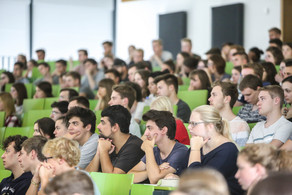Locate cars with traffic lane accuracy – the results of a dissertation show how it works…
- News
On 15 February 2016, Brian Niehöfer of the CNI has successfully completed his dissertation regarding “Modellbasierte Interferenzkompensation für die satellitengestützte Ortung in urbanen Szenarien” – we congratulate cordially!
So called Cyber-Physical Systems depends on precise location information, to reliably locate participating systems. For the derivation of dynamic traffic card data, that take short-term changes like temporary road works into account, it is therefore necessary to capture automotive movement at least traffic lane accurate. The precise localization is also essential for future autonomous vehicles. Today’s satellite based navigation systems do not offer the necessary accuracy, especially in inner city scenarios. Buildings disturb the visual contact to the satellite and distort the for the positioning required distance measurement to the satellite through multipath propagation. The work of Mr. Niehöfer takes care of the also known as “Urban Canyon” problem and presents a novel solution approach.
It determines occurring failures based on a 3D-modell of the system surroundings and the detailed consideration of satellite system characteristics in a specifically made Open Source Satellite Simulator (OS3). Using cloud-based resources it is possible to compensate most of the occurring failures as well as using them for embedded systems. The system concept was experimentally transcribed and validated by means of Software-Defined Radio platforms. Mr. Niehöfer demonstrates the practical applicability of the approach on the basis of two detailed case studies. Beginning the work the availability of high precision 3D-maps was utopian, today such maps are considered essential basis of autonomous driving.
The dissertation is develpoed within the scope of the DFG Collaborative Research Center SFB 876 "Providing Information by Resource-Constrained Data Analysis" and provides contributions to subproject B4 "Analysis and Communication for Dynamic Traffic Prognosis".





